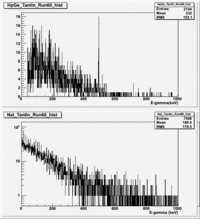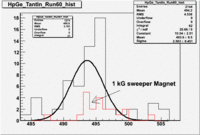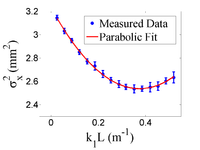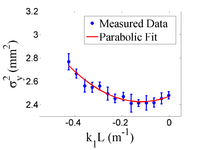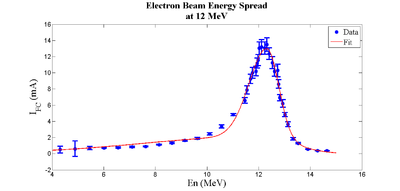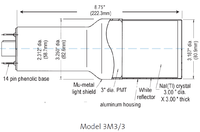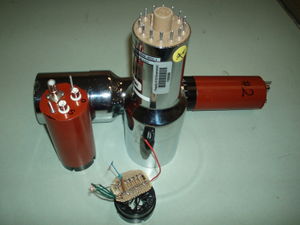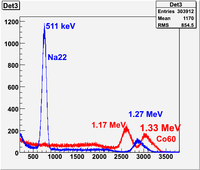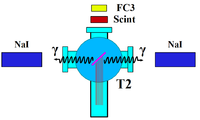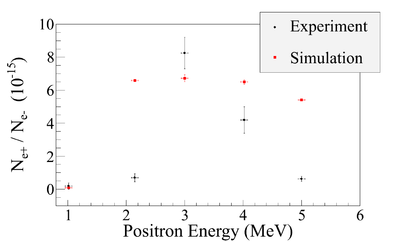JLAB Positron Source DOE Award DE-SC0002600
Award Info
8/15/09 - 8/14/2012
Funds Obligated: $381,509
Funds Requested: $411,509
Sponsored Project Proposal Number : 8-17
DOE Award Number : DE-SC0002600
Accounts set up on 10/14/09
Banner Index : RACL39 Account Numer : 684-143-40
Fund: X10165, Org code: 640000, Program : 040R0
Final Report
DOE Award #: DE-SC0002600
Project Title: The Development of a Positron Source for JLab at the IAC
Date: 8/1/13
Period covered: 8/15/09-8/14/2013 (Final Report)
Use the URL below to submit the final report
http://www.osti.gov/elink-2413
Accomplishments
The performance of positron source using a quad triplet collection system has been measured using the support from this award. The first year of research accomplished its goal of performing preliminary measurements of positron production and found that efficiency to be positrons per incident electron. The second year of work focused on designing an achromat beam line along with a tungsten target to optimize the production of positrons with an energy dispersion less than 30 \%. The third year measured the performance of a linac based, achromatic positron source and observed a chromaticity of 60\% while improving the positron production efficiency measured in year one by more than a factor of two. Based on this work, we believe that the low positron efficiency observed can be greatly improved by placing the production target within a magnetic collection field instead of outside.
Initial Positron production measurement
An initial set of positron production measurements were performed at the Idaho Accelerator Center (IAC) to evaluate the signal to background level and detector performance. Figure ~\ref{fig:Year1BeamLine} depicts the beam line used for these measurements. A 25 MeV linac, pulsed at 300 Hz, was used to accelerate electrons to 10 MeV. The electrons were bunched into 100 ns wide pulses with a peak current of 40 mA and transported to a 2 mm thick tungsten target located between two dipoles. The second dipole was set to transport 3 MeV electrons or positrons to a shielded cell that housed an HpGe and NaI detector.
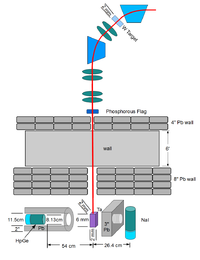 |
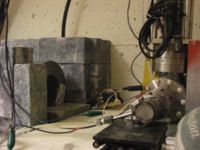
|
| The beam line used for an initial set of positron production measurements | A picture of the HgPe detector entrance and Farraday cup. |
| Item | Description |
| Tantalum Foil | 6 mm thick 20 mm x 20 mm area |
| Tungsten Foil | 2 mm thick 20 mm x 20 mm area |
| Phosphorus Flag | 1 mil aluminum backing |
| Media:HpGe_Crystal_GEM-60195-Plus-P.pdf | 81.3mm Diameter, 55.5mm Length |
| NaI detector |
A positron transported to the shielded cell would impinge onto a 6mm thick Tantalum foil where it would annihilate and produce two photons. An high purity germanium (HpGe) detector and an Sodium Iodide (NaI) detector were place at 90 degree angles with respect to the Tantalum target in order to detect the characteristic 511 keV photon that would emerge back to back when a positron annihilates after thermalizing in the Tantalum. The analog output of both detectors was measured using a multi-channel analyzer, model MPA-3 manufactured by FAST ComTec Communication Technology GmbH, equipped with a 12 bit ADC.
Figure~\ref{fig:IACpositronSpec} shows the photon energy spectrum observed by each detector. A clear peak at a photon distribution was observed using the HpGe detector while the NaI spectrum was less clear. A permanent magnet was inserted to deflect charged particles away from the Tantalum annihilation target. Figure~\ref{fig:IACpositronSpec} shows the reduction in the 511 keV peak observed by the HpGe detector when the magnet is inserted. Although the HpGe detector calibration was off by 15 keV, the magnet indicated that positively charged particles were being produced and transported to the shielded cell. We did not have the diagnostic equipment needed to determine if those particles were from the Tungsten converter target or created somewhere along the beam line. Our next measurement would use retractable targets to determine the origin of the positively charged particles producing the 511 keV photons.
The design of a linac based positron source
The first year's research experience was used to design a beam line specifically for use as a positron source. The first step was to ncrease the available space for a beam line by moving the High Repetition Rate Linac (HRRL) cavity from the center of the Physic's beam lab room to a corner and add a system of quads and steering magnets improve beam transport. The second step was to measure the emittance of the linac and use use those measurements as the input parameters of a beam line simulation to optimize positron transport.
Beamline Optimization
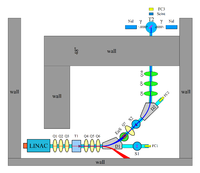 |
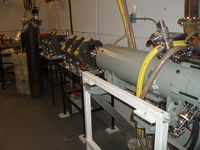
|
| HRRL beamline for positron generation. | A picture of the HRRL positron beam line. |
The HRRL's accelerator cavity was relocated to the position shown in the Fig.~\ref{fig:app-hrrl-line} to provide enough space for a beam line that can transport either positrons or electrons. The beam elements are described in Table~\ref{tab:app-hrrl-coordinates}. Quadrupole and dipole magnets were added to the new beam line as well as diagnostic tools like an optial transmission radiator (OTR) and YAG screens, Faraday cups and toroids were installed to measure the electron beam size and the current. Energy slits were installed to restrict energy/momentum spread of the beam after the first dipole. A retractable tungsten foil target (T1) was placed between the 1st and 2nd triplets and used produce positrons when the electron beam interacts with it.
The room where the HRRL is located is divided by a wall into two parts; the accelerator side and the experimental cell. A beam pipe at the end of the 90 degree beamline goes through a hole on the wall and delivers the beam from the accelerator side to the experimental cell. The positron detection system consisting of two NaI detectors was placed at the end of the beamline in the experimental cell side as shown in the Fig.~\ref{fig:app-hrrl-line}.
HRRL emittance measurements
Images from the JAI camera were calibrated using the OTR target frame. An LED was used to illuminate the OTR aluminum frame that has a known inner diameter of 31.75~mm. Image processing software was used to inscribe a circle on the image and measure the circular OTR inner frame in units of pixels. The scaling factor can be obtained by dividing this length with the number of pixels observed. The result is a horizontal scaling factor of 0.04327~\pm~0.00016~mm/pixel and vertical scaling factor of 0.04204~\pm~0.00018~mm/pixel. Digital images from the JAI camera were extracted in a matrix format in order to take projections on both axes and perform a Gaussian fit. The observed image profiles were not well described by a single Gaussian distribution. The profiles may be described using a Lorentzian distribution, however, the rms of the Lorentzian function is not defined. The super Gaussian distribution seems to be the best option~[11], because rms values may be directly extracted.
Fig.~\ref{par-fit} shows the square of the rms (\sigma^2_{s}) vs k_1L for x (horizontal) and y (vertical) beam projections along with the parabolic fits using Eq.~\ref{par_fit}. The emittances and Twiss parameters from these fits are summarized in Table~\ref{results}.
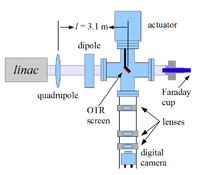
|
| Parameter | Unit | Value | |
| projected emittance | m | 0.37 0.02 | |
| projected emittance | m | 0.30 0.04 | |
| -function | m | 1.40 0.06 | |
| -function | m | 1.17 0.13 | |
| -function | rad | 0.97 0.06 | |
| -function | rad | 0.24 0.07 | |
| micro-pulse charge | pC | 11 | |
| micro-pulse length | ps | 35 | |
| energy of the beam E | MeV | 15 1.6 | |
| relative energy spread | % | 10.4 |
HRRL energy spread
Energy scan was done to measure the energy profile of HRRL at nominal 12 MeV. A Faraday cup was placed at the end of the 45 degree beamline to measure the electron beam current bent by the first dipole. Dipole coil current were changed by 1 A increment and the Faraday cup currents were recorded. The scan results with corresponding beam energies are shown in the table below. The relation between dipole current and beam energy is given in the appendix.
The energy distribution of HRRL can be described by two skewed Gaussian fit overlapping.
The beam energy spread does not follow Gaussian distribution, but the overlapping of two skewed Gaussian found to be the best description of beam energy profile Media:Beam_Distributions_Beyond_RMS.pdf.
| parameter | Notation | First Gaussian | Second Gaussian |
| amplitude | A | 2.13894 | 10.88318 |
| mean | 12.07181 | 12.32332 | |
| sigma left | 4.46986 | 0.69709 | |
| sigma right | 1.20046 | 0.45170 |
Positron converter target
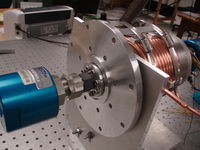 |
|
| A picture of the rotating target motor with cooling lines. |
Positron Production Performance
| run in: 3735 | 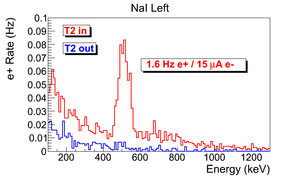
|
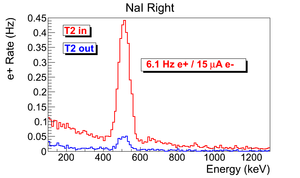
|
| Singles spectra for each detector with and without the annihilation target inserted |
This a normalized spectrum (no background subtraction).
| run in: 3735 | 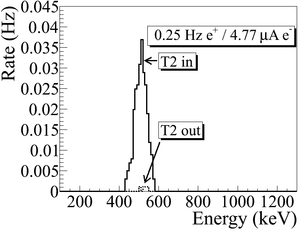
|
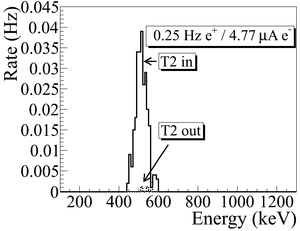
|
| Coincidence spectra. |
positron rate: .
Things not accomplished
No Positron workshop but rather a PePPO collaboration meeting
Used OTR to measure emmittance.
Positron current was too low for a FC measurement
